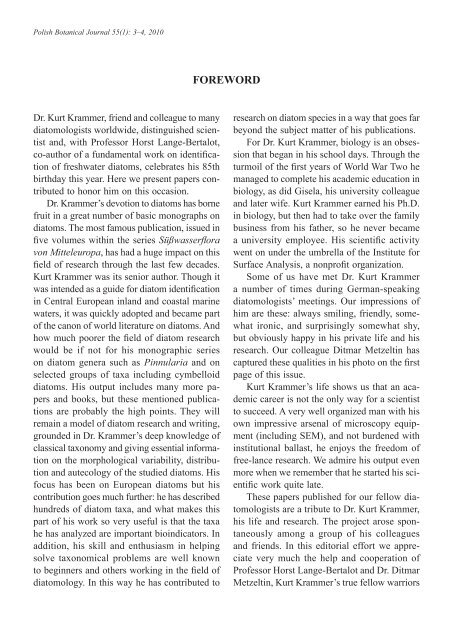Pbj551_s001-26.pdf
Pbj551_s001-26.pdf
Pbj551_s001-26.pdf
Create successful ePaper yourself
Turn your PDF publications into a flip-book with our unique Google optimized e-Paper software.
Polish Botanical Journal 55(1): 3–4, 2010<br />
Dr. Kurt Krammer, friend and colleague to many<br />
diatomologists worldwide, distinguished scientist<br />
and, with Professor Horst Lange-Bertalot,<br />
co-author of a fundamental work on identifi cation<br />
of freshwater diatoms, celebrates his 85th<br />
birthday this year. Here we present papers contributed<br />
to honor him on this occasion.<br />
Dr. Krammer’s devotion to diatoms has borne<br />
fruit in a great number of basic monographs on<br />
diatoms. The most famous publication, issued in<br />
fi ve volumes within the series Süßwasserfl ora<br />
von Mitteleuropa, has had a huge impact on this<br />
fi eld of research through the last few decades.<br />
Kurt Krammer was its senior author. Though it<br />
was intended as a guide for diatom identifi cation<br />
in Central European inland and coastal marine<br />
waters, it was quickly adopted and became part<br />
of the canon of world literature on diatoms. And<br />
how much poorer the fi eld of diatom research<br />
would be if not for his monographic series<br />
on diatom genera such as Pinnularia and on<br />
selected groups of taxa including cymbelloid<br />
diatoms. His output includes many more papers<br />
and books, but these mentioned publications<br />
are probably the high points. They will<br />
remain a model of diatom research and writing,<br />
grounded in Dr. Krammer’s deep knowledge of<br />
classical taxonomy and giving essential information<br />
on the morphological variability, distribution<br />
and autecology of the studied diatoms. His<br />
focus has been on European diatoms but his<br />
contribution goes much further: he has described<br />
hundreds of diatom taxa, and what makes this<br />
part of his work so very useful is that the taxa<br />
he has analyzed are important bioindicators. In<br />
addition, his skill and enthusiasm in helping<br />
solve taxonomical problems are well known<br />
to beginners and others working in the fi eld of<br />
diatomology. In this way he has contributed to<br />
FOREWORD<br />
research on diatom species in a way that goes far<br />
beyond the subject matter of his publications.<br />
For Dr. Kurt Krammer, biology is an obsession<br />
that began in his school days. Through the<br />
turmoil of the fi rst years of World War Two he<br />
managed to complete his academic education in<br />
biology, as did Gisela, his university colleague<br />
and later wife. Kurt Krammer earned his Ph.D.<br />
in biology, but then had to take over the family<br />
business from his father, so he never became<br />
a university employee. His scientifi c activity<br />
went on under the umbrella of the Institute for<br />
Surface Analysis, a nonprofi t organization.<br />
Some of us have met Dr. Kurt Krammer<br />
a number of times during German-speaking<br />
diatomologists’ meetings. Our impressions of<br />
him are these: always smiling, friendly, somewhat<br />
ironic, and surprisingly somewhat shy,<br />
but obviously happy in his private life and his<br />
research. Our colleague Ditmar Metzeltin has<br />
captured these qualities in his photo on the fi rst<br />
page of this issue.<br />
Kurt Krammer’s life shows us that an academic<br />
career is not the only way for a scientist<br />
to succeed. A very well organized man with his<br />
own impressive arsenal of microscopy equipment<br />
(including SEM), and not burdened with<br />
institutional ballast, he enjoys the freedom of<br />
free-lance research. We admire his output even<br />
more when we remember that he started his scientifi<br />
c work quite late.<br />
These papers published for our fellow diatomologists<br />
are a tribute to Dr. Kurt Krammer,<br />
his life and research. The project arose spontaneously<br />
among a group of his colleagues<br />
and friends. In this editorial effort we appreciate<br />
very much the help and cooperation of<br />
Professor Horst Lange-Bertalot and Dr. Ditmar<br />
Metzeltin, Kurt Krammer’s true fellow warriors

















